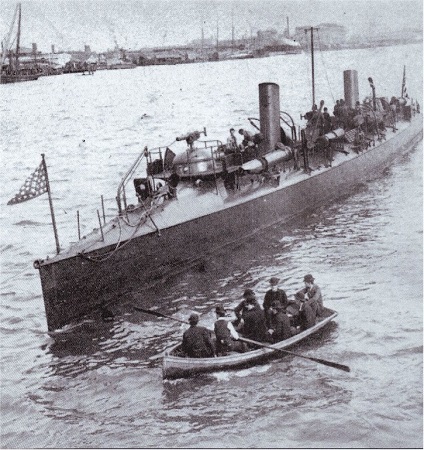


After commissioning, USS WINSLOW reported to Newport, Rhode Island for torpedo loading and drilling She remained there until January 30, 1898 when she departed for Norfolk, Virginia. She was in Norfolk when word arrived about the loss of the USS MAINE. With the heightening of tensions in March, she was dispatched to Key West, Florida to be closer at hand should hostilities break out.
After War was declared, the USS WINSLOW patrolled off of the Cuban coast in the vicinity of Havana, Cardenas and Matanzas. She left her patrol area on May 11 to meet the USS WILMINGTON (Gunboat #8) for recoaling. While there, she aided the USS WILMINGTON, and the USS HUDSON in an effort to locate Spanish vessels in Cardenas Harbor. The action against the town and the Spanish armored tug ANTONIO LOPEZ resulted in the near loss of the USS WINSLOW, and the death of six of her crew, including Ensign Worth Bagley, the only U.S. naval officer killed during the war. Three of her men, Chief Gunner's Mate George P. Brady, Chief Gunner's Mate Hans Johnsen, and Chief Machinist T. C. Cooney were awarded the Congressional Medal of Honor. Click Here for the official account of this action.
After being towed clear of the battle, the USS WINSLOW was sent to Key West, Florida and Mobile, Alabama for repairs. The repairs were not completed before the end of hostilities. She sailed up the east coast, arriving in New York, where she was placed out of commission on September 7 to begin more extensive repairs. She stayed in New York until transferred to Norfolk where she was recommissioned in reserve.
The USS WINSLOW was fully recommissioned June 30, 1901, to served as a torpedo training vessel at Newport, Rhode Island. She was probably decommissioned in 1904 in New York. In 1906 she was recommissioned and sent to Norfolk where she was placed in the Reserve Torpedo Flotilla. In 1909, the USS WINSLOW was transferred to Charleston, South Carolina, but still held in reserve.
From June to November 1909, the ship served as a training vessel for the Massachusetts Naval Militia. The ship was returned to the Navy and decommissioned on July 12, 1910. In January 1911, she was sold to H. Hanson of New York City.
Torpedo boats were a new type of vessel world-wide. They were greatly feared, but were highly ineffective. The theory was that the torpedo boats could advance quickly, because of their high speed, and stealthily, possibly at night, and release their torpedoes at a range of four hundred yards or less. The torpedo would travel just below the waterline, and pierce the enemy vessel's hull just below the main armor belt. By the time the United States commissioned its first torpedo boat, the five major navies in the world already had nine hundred torpedo boats among them.
Several major factors contributed to the actual ineffectiveness of torpedo boats such as the USS WINSLOW. First, the vessels had to approach very close to the targeted enemy vessel to fire their torpedoes. The requirement of close approach combined with lack of armor made the vessel subject to rapid damage. The navy had little experience in the operation of torpedo boats and did not use the vessels as they were intended, such as dispatch boats and as patrol boats. The torpedo boat's low coal bunker capacity made the vessels unable to stay at sea for an extended period of time. As a dispatch boat, the vessels were run at higher than the usual cruising speed exacerbating the low bunker capacity issue (doubling speed generally resulted in using coal eight times as fast). Though torpedo boats did not inflict any major damage during the war, the sheer threat of their existence was a weapon. It required the development of counter-measures, caused an alteration of tactics, and was useful as a weapon of terror. Still, by the end of the war, the U.S. Navy generally looked upon the vessels as being ineffective.| Classification: | Torpedo Boat TB 5 (FOOTE Class) | |
|---|---|---|
| Keel Laid: | May 8, 1896 | |
| Completed: | August 3, 1896 | |
| Commissioned: | December 29, 1897 | |
| Armament: | Three 1-pounders | |
| Three 18" Whitehead torpedo tubes | ||
| Contractor: | Columbia Iron Works, Baltimore, MD | |
| Length: | 160 feet 4 inches | |
| Beam: | 16 feet 3/4 inch | |
| Mean draft: | 5 feet | |
| Displacement: | 142 tons | |
| Complement: | 4 officers and 20 enlisted men commanded by Lt. J. B. Bernadou, | |
| Engine type: | Vertical triple expansion engines with a 22 inch stroke, generating 2,000 hp. Twin screw. Some sources list her as having quadruple expansion engines | |
| Boiler type: | Two Mosher Tubulous boilers. | |
| Speed: | 24.82 knots | |
| Coal bunker capacity: | 32 tons | |
| Normal coal supply: | 9 tons | |
| Endurance @ 10 knots: | 1200 nautical miles | |
| Armor: | None | |
| Cost: | $97,000 |
Alden, John D., The American Steel Navy. (Annapolis: Naval
Institute Press, 1972), 104.
Clerk of Joint Committee on Printing, The Abridgement of Message from the President of the United States to the Two Houses of Congress, Vol. 2 (Washington: Government Printing Office, 1899).
Harris, Lt. Cmdr. Brayton, The Age of the Battleship. (New York: Franklin Watts, Inc., 1965).